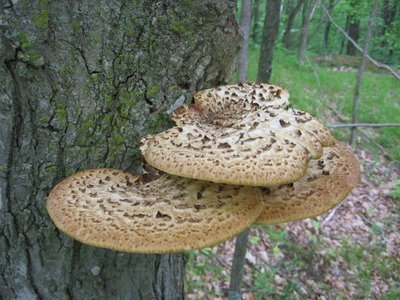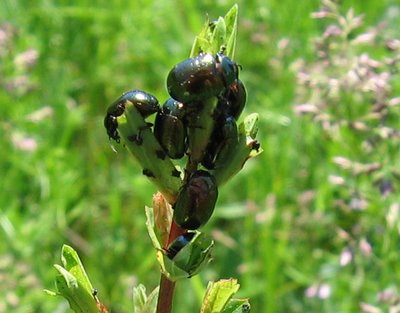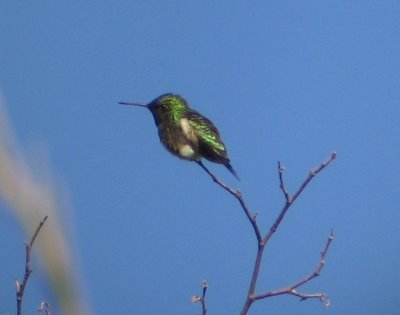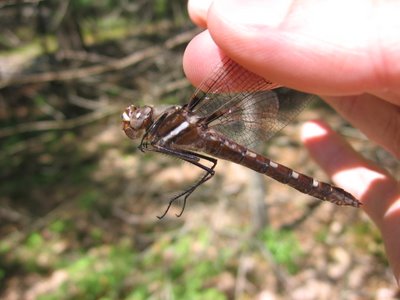
Monday, June 26, 2006
White Admiral
 Algonquin Provincial Park, Bat Lake
Algonquin Provincial Park, Bat Lake25 June, 2006
Whatever was in this scat, the butterflies really seemed to be enjoying. Being in shit doesn't always mean you're in trouble.
Check out this posting at Bootstrap Analysis for more on Lepidoptera and scat. Thanks to Norene for the link!
Suillus granulatus

 Algonquin Park, Bat Lake
Algonquin Park, Bat Lake25 June, 2006
This was growing beside the path in some moss. The roots were anchored to the rootlet of a coniferous tree. The cap was 7.5 cm. The stem was 8 cm. The flesh inside the cap is white. The brown skin peels off easily to reveal the white flesh.
Identifying almost any mushroom can be very difficult. In this case one look at the pore surface tells you that it is a Bolete. The two subgroups, Boletus and Tylopilus usually have stalks that are covered with a network of veins (i.e. are reticulate). In the subgroup Leccinum the stalk is always Scabrous. In the subgroup Suillus the stalk frequently has these speckled, glabrous, dots. All of this I determined from looking at "Mushrooms Demystified" by David Arora. I then went to the key in "Mushrooms of Northeastern North America" by Bessette, Bessette, and Fischer and looked at the key for Suillus. This guide is my first choice because it deals only with mushrooms of the Northeastern area. The description and picture of S. granulatus best met the mushroom that I was looking at.
Crimson-Ringed Whiteface
 Leucorrhinia glacialis
Leucorrhinia glacialisAlgonquin Park, Bat Lake
25 June, 2006
Dunkle says that it is impossible to tell the male Crimson-Ringed Whiteface from the male red form Red-Waisted Whiteface. I have opted for my identification on the basis of some circumstantial evidence. Dunkle says that males from Ontario eastward are mostly White Form. Crimson-Ringed and Red-Waisted both frequent boggy, marshy, habitat and from May to August or September.
Algonquin Provincial Park: Bat Lake
 A view from the Bat Lake hiking trail
A view from the Bat Lake hiking trail25 June, 2006
I took my son back to Algonquin for his second summer working as a Park Naturalist. After I dropped him off I hiked the 5.6 km Bat Lake trail. It was overcast most of the time so not the best for odes. I photographed a few interesting mushrooms and some insects. Because the brush was so dense most of the time there was little to see. I understand Bat Lake is a good spot for odeing because there are no fish in the Lake. I did see a few different species: the ubiquitous Chalk-fronted Corporal, a couple of Widow Skimmers, and many White-face.
Monday, June 19, 2006
Monday, June 05, 2006
Frontenac Park Odonates: May 27, 2006
Frontenac Park: May 27, 2006
 Wood Thrush
Wood ThrushThis was a new bird for my list. He was quite high up but I was able to scope him. Notice the bold white eyering and bold black spots on white underside.
 Parasitoid Wasp
Parasitoid WaspThis wasp had paralyzed its prey and was taking it to who knows where. We watched it for quite a while as it dragged this spider along the ground. At times he would abandon it and fly a short distance away but soon came back and began to drag it again. I don't know if he ever got it to his destination.
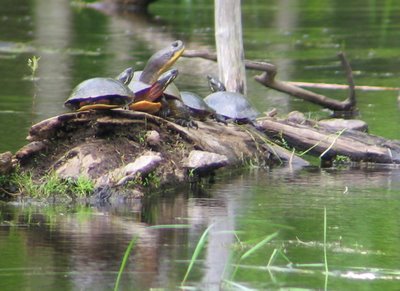 Blandings Turtle
Blandings TurtleThe Blandings is common in certain locations in the Park. We found these turtles on two different ponds on this trip. It is under study in the Park because of its troubled status in the Province.
This was mainly a dragonfly outing and we were not disappointed. We found many different species including the Harlequin Darner, which does not have an official record in Frontenac County according to the Odonate Database.
Subscribe to:
Comments (Atom)







